Human Resources Management Report: Canary Wharf Case Study
VerifiedAdded on 2020/01/07
|17
|5130
|127
Report
AI Summary
This report provides a comprehensive analysis of Human Resources Management (HRM), focusing on its purpose, functions, and practical applications within the Canary Wharf company. The report delves into the core aspects of HRM, including recruitment and selection strategies, exploring both internal and external factors, and evaluating the strengths and weaknesses of different approaches. It highlights the benefits of HRM practices for both employers and employees, covering aspects like support, guidance, training, and the development of planning decisions. The report also examines the effectiveness of HRM practices in enhancing organizational profits and productivity, emphasizing the significance of strategy, compensation, and employee relations. Furthermore, it explores the importance of employee relations in HRM decision-making and outlines the key elements of employment legislation. The report concludes by examining HRM practices in a work-related context, providing a holistic understanding of HRM's role in organizational success.
Human Resources
Management
Management
Paraphrase This Document
Need a fresh take? Get an instant paraphrase of this document with our AI Paraphraser
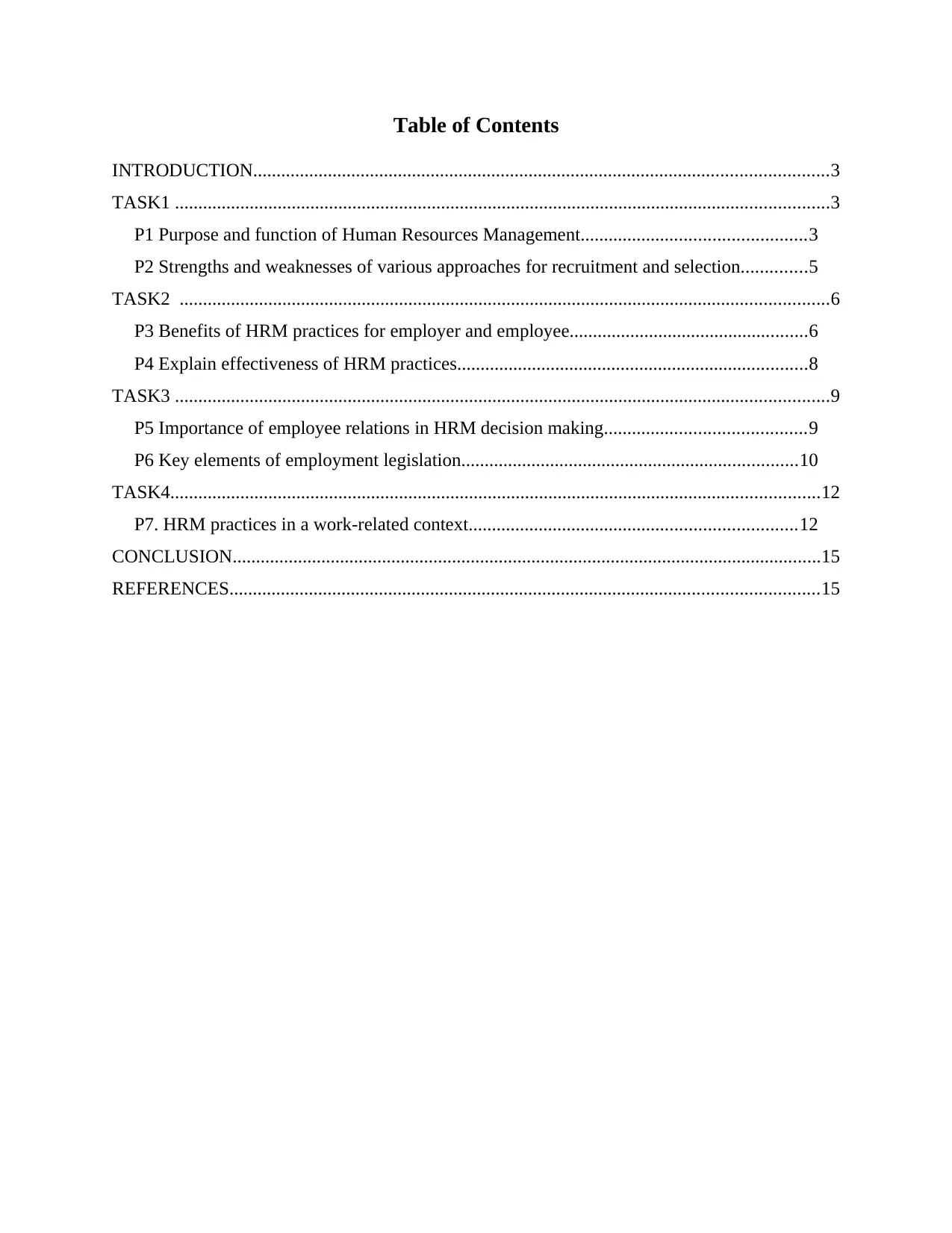
Table of Contents
INTRODUCTION...........................................................................................................................3
TASK1 ............................................................................................................................................3
P1 Purpose and function of Human Resources Management................................................3
P2 Strengths and weaknesses of various approaches for recruitment and selection..............5
TASK2 ...........................................................................................................................................6
P3 Benefits of HRM practices for employer and employee...................................................6
P4 Explain effectiveness of HRM practices...........................................................................8
TASK3 ............................................................................................................................................9
P5 Importance of employee relations in HRM decision making...........................................9
P6 Key elements of employment legislation........................................................................10
TASK4...........................................................................................................................................12
P7. HRM practices in a work-related context......................................................................12
CONCLUSION..............................................................................................................................15
REFERENCES..............................................................................................................................15
INTRODUCTION...........................................................................................................................3
TASK1 ............................................................................................................................................3
P1 Purpose and function of Human Resources Management................................................3
P2 Strengths and weaknesses of various approaches for recruitment and selection..............5
TASK2 ...........................................................................................................................................6
P3 Benefits of HRM practices for employer and employee...................................................6
P4 Explain effectiveness of HRM practices...........................................................................8
TASK3 ............................................................................................................................................9
P5 Importance of employee relations in HRM decision making...........................................9
P6 Key elements of employment legislation........................................................................10
TASK4...........................................................................................................................................12
P7. HRM practices in a work-related context......................................................................12
CONCLUSION..............................................................................................................................15
REFERENCES..............................................................................................................................15
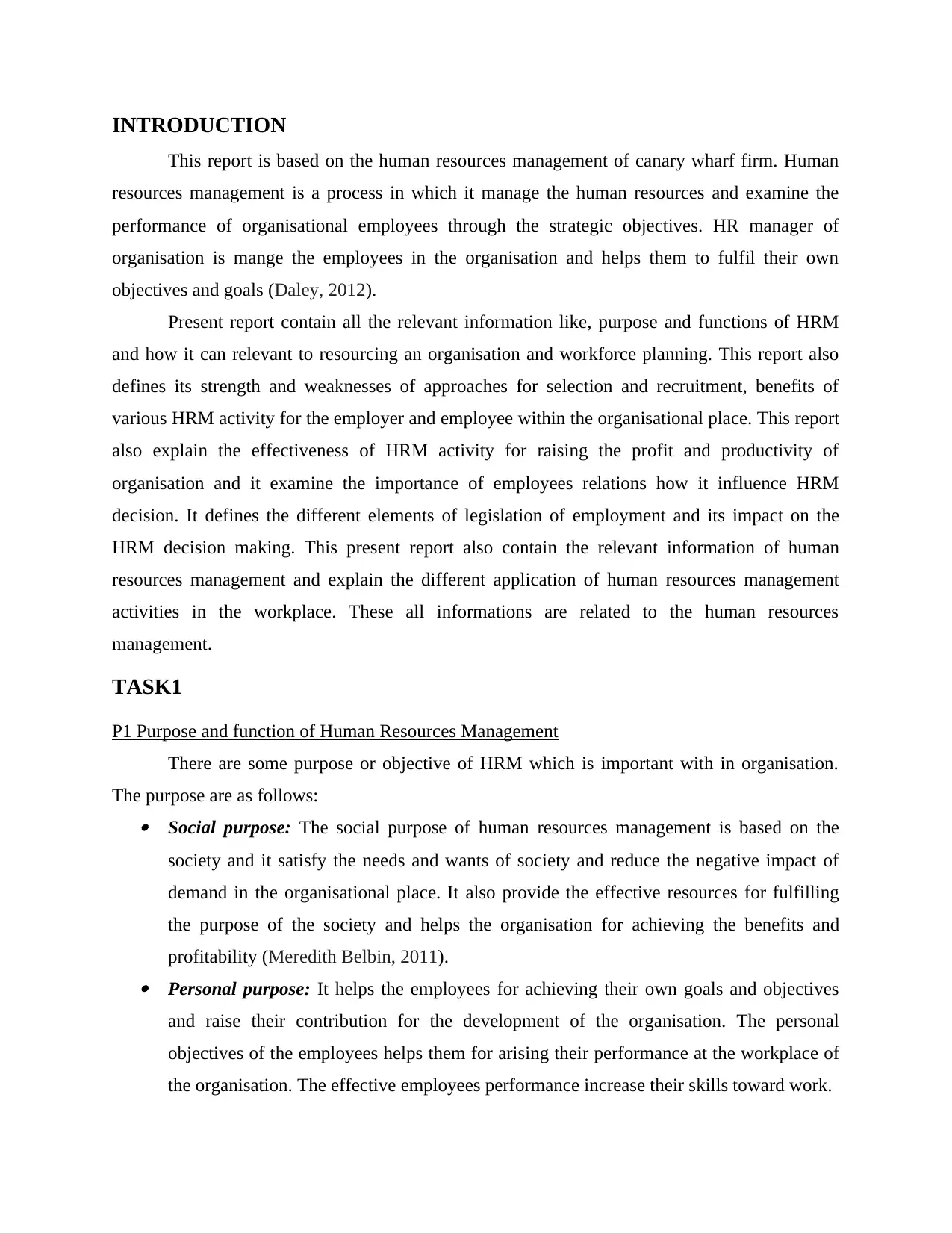
INTRODUCTION
This report is based on the human resources management of canary wharf firm. Human
resources management is a process in which it manage the human resources and examine the
performance of organisational employees through the strategic objectives. HR manager of
organisation is mange the employees in the organisation and helps them to fulfil their own
objectives and goals (Daley, 2012).
Present report contain all the relevant information like, purpose and functions of HRM
and how it can relevant to resourcing an organisation and workforce planning. This report also
defines its strength and weaknesses of approaches for selection and recruitment, benefits of
various HRM activity for the employer and employee within the organisational place. This report
also explain the effectiveness of HRM activity for raising the profit and productivity of
organisation and it examine the importance of employees relations how it influence HRM
decision. It defines the different elements of legislation of employment and its impact on the
HRM decision making. This present report also contain the relevant information of human
resources management and explain the different application of human resources management
activities in the workplace. These all informations are related to the human resources
management.
TASK1
P1 Purpose and function of Human Resources Management
There are some purpose or objective of HRM which is important with in organisation.
The purpose are as follows: Social purpose: The social purpose of human resources management is based on the
society and it satisfy the needs and wants of society and reduce the negative impact of
demand in the organisational place. It also provide the effective resources for fulfilling
the purpose of the society and helps the organisation for achieving the benefits and
profitability (Meredith Belbin, 2011). Personal purpose: It helps the employees for achieving their own goals and objectives
and raise their contribution for the development of the organisation. The personal
objectives of the employees helps them for arising their performance at the workplace of
the organisation. The effective employees performance increase their skills toward work.
This report is based on the human resources management of canary wharf firm. Human
resources management is a process in which it manage the human resources and examine the
performance of organisational employees through the strategic objectives. HR manager of
organisation is mange the employees in the organisation and helps them to fulfil their own
objectives and goals (Daley, 2012).
Present report contain all the relevant information like, purpose and functions of HRM
and how it can relevant to resourcing an organisation and workforce planning. This report also
defines its strength and weaknesses of approaches for selection and recruitment, benefits of
various HRM activity for the employer and employee within the organisational place. This report
also explain the effectiveness of HRM activity for raising the profit and productivity of
organisation and it examine the importance of employees relations how it influence HRM
decision. It defines the different elements of legislation of employment and its impact on the
HRM decision making. This present report also contain the relevant information of human
resources management and explain the different application of human resources management
activities in the workplace. These all informations are related to the human resources
management.
TASK1
P1 Purpose and function of Human Resources Management
There are some purpose or objective of HRM which is important with in organisation.
The purpose are as follows: Social purpose: The social purpose of human resources management is based on the
society and it satisfy the needs and wants of society and reduce the negative impact of
demand in the organisational place. It also provide the effective resources for fulfilling
the purpose of the society and helps the organisation for achieving the benefits and
profitability (Meredith Belbin, 2011). Personal purpose: It helps the employees for achieving their own goals and objectives
and raise their contribution for the development of the organisation. The personal
objectives of the employees helps them for arising their performance at the workplace of
the organisation. The effective employees performance increase their skills toward work.
⊘ This is a preview!⊘
Do you want full access?
Subscribe today to unlock all pages.

Trusted by 1+ million students worldwide
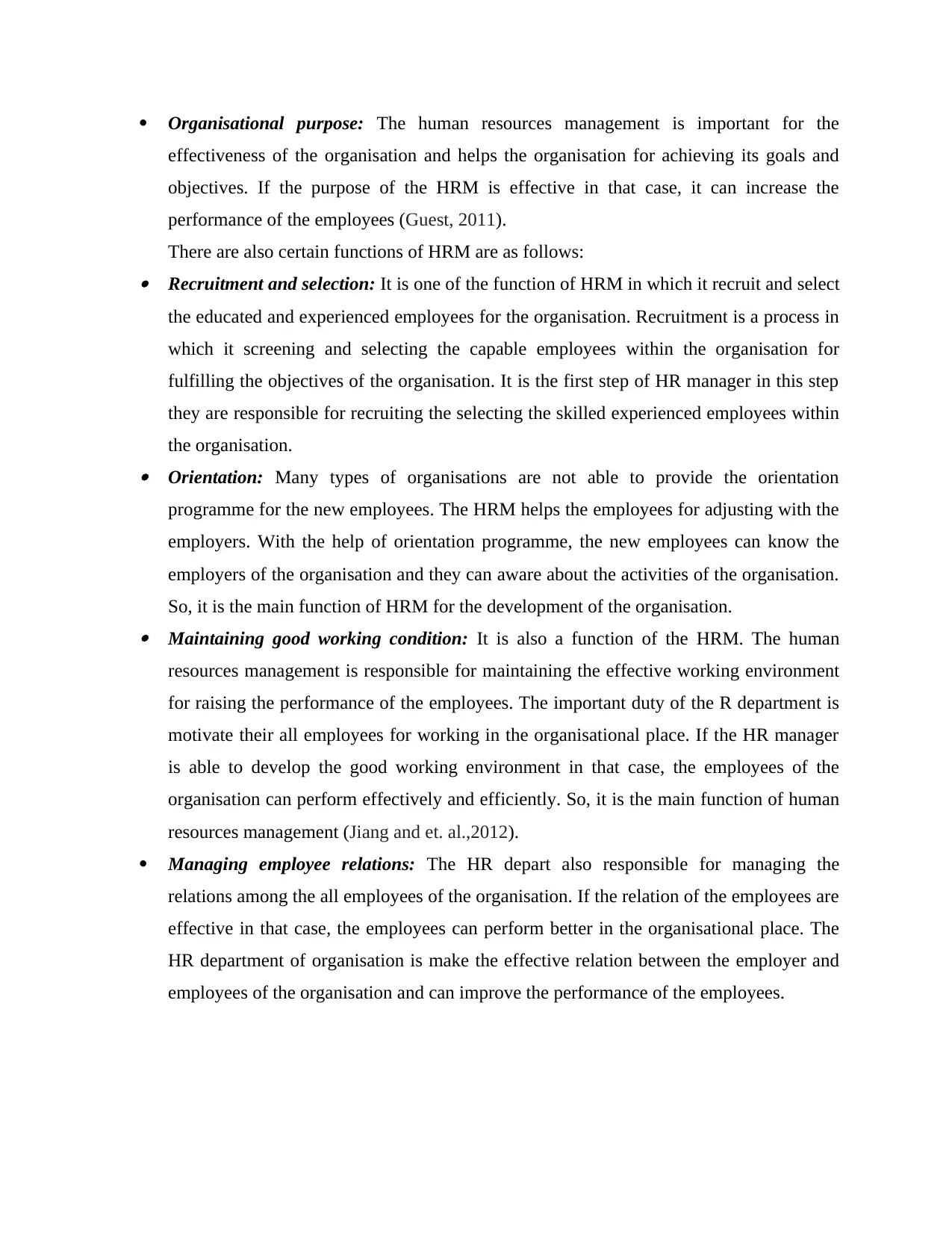
Organisational purpose: The human resources management is important for the
effectiveness of the organisation and helps the organisation for achieving its goals and
objectives. If the purpose of the HRM is effective in that case, it can increase the
performance of the employees (Guest, 2011).
There are also certain functions of HRM are as follows: Recruitment and selection: It is one of the function of HRM in which it recruit and select
the educated and experienced employees for the organisation. Recruitment is a process in
which it screening and selecting the capable employees within the organisation for
fulfilling the objectives of the organisation. It is the first step of HR manager in this step
they are responsible for recruiting the selecting the skilled experienced employees within
the organisation. Orientation: Many types of organisations are not able to provide the orientation
programme for the new employees. The HRM helps the employees for adjusting with the
employers. With the help of orientation programme, the new employees can know the
employers of the organisation and they can aware about the activities of the organisation.
So, it is the main function of HRM for the development of the organisation. Maintaining good working condition: It is also a function of the HRM. The human
resources management is responsible for maintaining the effective working environment
for raising the performance of the employees. The important duty of the R department is
motivate their all employees for working in the organisational place. If the HR manager
is able to develop the good working environment in that case, the employees of the
organisation can perform effectively and efficiently. So, it is the main function of human
resources management (Jiang and et. al.,2012).
Managing employee relations: The HR depart also responsible for managing the
relations among the all employees of the organisation. If the relation of the employees are
effective in that case, the employees can perform better in the organisational place. The
HR department of organisation is make the effective relation between the employer and
employees of the organisation and can improve the performance of the employees.
effectiveness of the organisation and helps the organisation for achieving its goals and
objectives. If the purpose of the HRM is effective in that case, it can increase the
performance of the employees (Guest, 2011).
There are also certain functions of HRM are as follows: Recruitment and selection: It is one of the function of HRM in which it recruit and select
the educated and experienced employees for the organisation. Recruitment is a process in
which it screening and selecting the capable employees within the organisation for
fulfilling the objectives of the organisation. It is the first step of HR manager in this step
they are responsible for recruiting the selecting the skilled experienced employees within
the organisation. Orientation: Many types of organisations are not able to provide the orientation
programme for the new employees. The HRM helps the employees for adjusting with the
employers. With the help of orientation programme, the new employees can know the
employers of the organisation and they can aware about the activities of the organisation.
So, it is the main function of HRM for the development of the organisation. Maintaining good working condition: It is also a function of the HRM. The human
resources management is responsible for maintaining the effective working environment
for raising the performance of the employees. The important duty of the R department is
motivate their all employees for working in the organisational place. If the HR manager
is able to develop the good working environment in that case, the employees of the
organisation can perform effectively and efficiently. So, it is the main function of human
resources management (Jiang and et. al.,2012).
Managing employee relations: The HR depart also responsible for managing the
relations among the all employees of the organisation. If the relation of the employees are
effective in that case, the employees can perform better in the organisational place. The
HR department of organisation is make the effective relation between the employer and
employees of the organisation and can improve the performance of the employees.
Paraphrase This Document
Need a fresh take? Get an instant paraphrase of this document with our AI Paraphraser
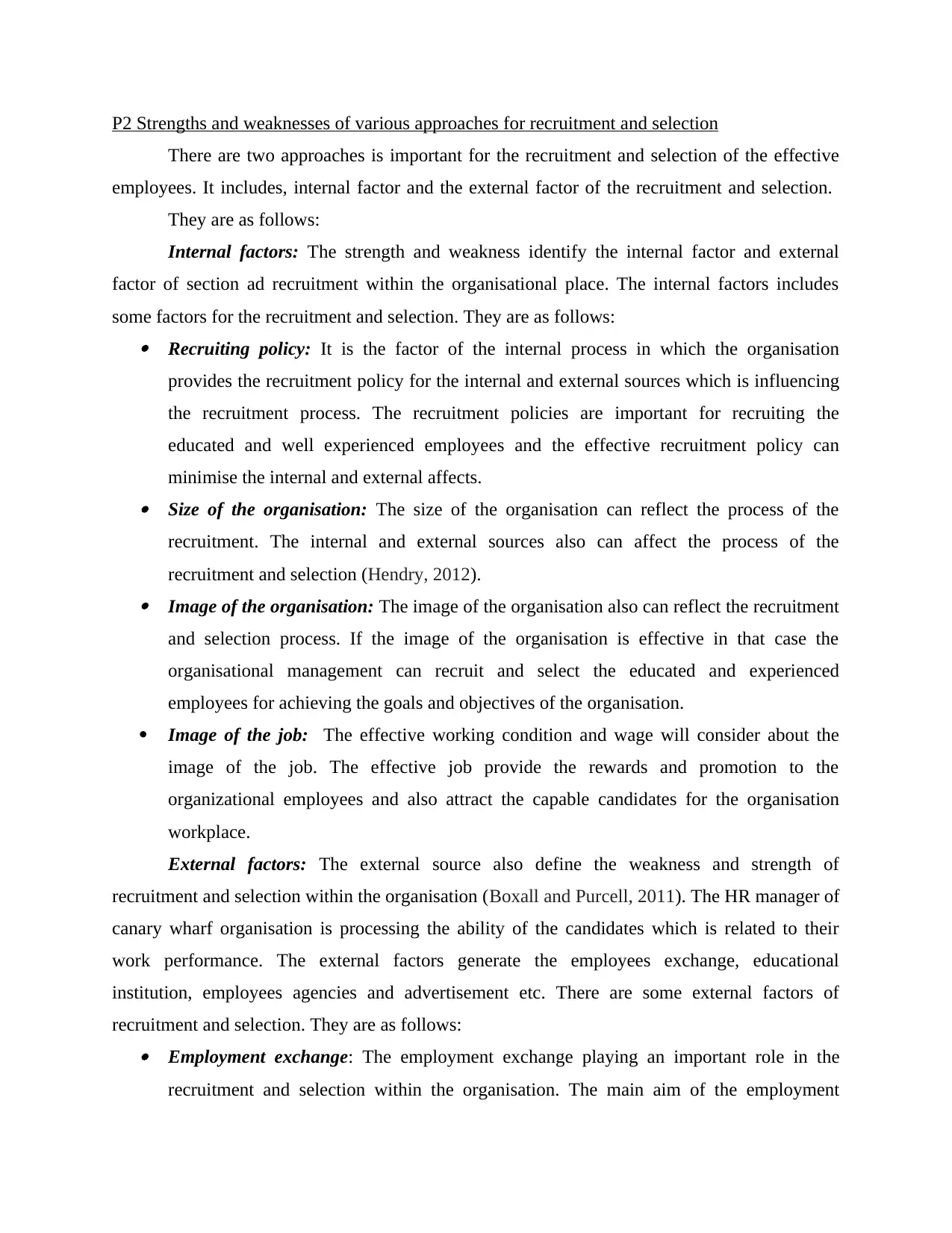
P2 Strengths and weaknesses of various approaches for recruitment and selection
There are two approaches is important for the recruitment and selection of the effective
employees. It includes, internal factor and the external factor of the recruitment and selection.
They are as follows:
Internal factors: The strength and weakness identify the internal factor and external
factor of section ad recruitment within the organisational place. The internal factors includes
some factors for the recruitment and selection. They are as follows: Recruiting policy: It is the factor of the internal process in which the organisation
provides the recruitment policy for the internal and external sources which is influencing
the recruitment process. The recruitment policies are important for recruiting the
educated and well experienced employees and the effective recruitment policy can
minimise the internal and external affects. Size of the organisation: The size of the organisation can reflect the process of the
recruitment. The internal and external sources also can affect the process of the
recruitment and selection (Hendry, 2012). Image of the organisation: The image of the organisation also can reflect the recruitment
and selection process. If the image of the organisation is effective in that case the
organisational management can recruit and select the educated and experienced
employees for achieving the goals and objectives of the organisation.
Image of the job: The effective working condition and wage will consider about the
image of the job. The effective job provide the rewards and promotion to the
organizational employees and also attract the capable candidates for the organisation
workplace.
External factors: The external source also define the weakness and strength of
recruitment and selection within the organisation (Boxall and Purcell, 2011). The HR manager of
canary wharf organisation is processing the ability of the candidates which is related to their
work performance. The external factors generate the employees exchange, educational
institution, employees agencies and advertisement etc. There are some external factors of
recruitment and selection. They are as follows: Employment exchange: The employment exchange playing an important role in the
recruitment and selection within the organisation. The main aim of the employment
There are two approaches is important for the recruitment and selection of the effective
employees. It includes, internal factor and the external factor of the recruitment and selection.
They are as follows:
Internal factors: The strength and weakness identify the internal factor and external
factor of section ad recruitment within the organisational place. The internal factors includes
some factors for the recruitment and selection. They are as follows: Recruiting policy: It is the factor of the internal process in which the organisation
provides the recruitment policy for the internal and external sources which is influencing
the recruitment process. The recruitment policies are important for recruiting the
educated and well experienced employees and the effective recruitment policy can
minimise the internal and external affects. Size of the organisation: The size of the organisation can reflect the process of the
recruitment. The internal and external sources also can affect the process of the
recruitment and selection (Hendry, 2012). Image of the organisation: The image of the organisation also can reflect the recruitment
and selection process. If the image of the organisation is effective in that case the
organisational management can recruit and select the educated and experienced
employees for achieving the goals and objectives of the organisation.
Image of the job: The effective working condition and wage will consider about the
image of the job. The effective job provide the rewards and promotion to the
organizational employees and also attract the capable candidates for the organisation
workplace.
External factors: The external source also define the weakness and strength of
recruitment and selection within the organisation (Boxall and Purcell, 2011). The HR manager of
canary wharf organisation is processing the ability of the candidates which is related to their
work performance. The external factors generate the employees exchange, educational
institution, employees agencies and advertisement etc. There are some external factors of
recruitment and selection. They are as follows: Employment exchange: The employment exchange playing an important role in the
recruitment and selection within the organisation. The main aim of the employment
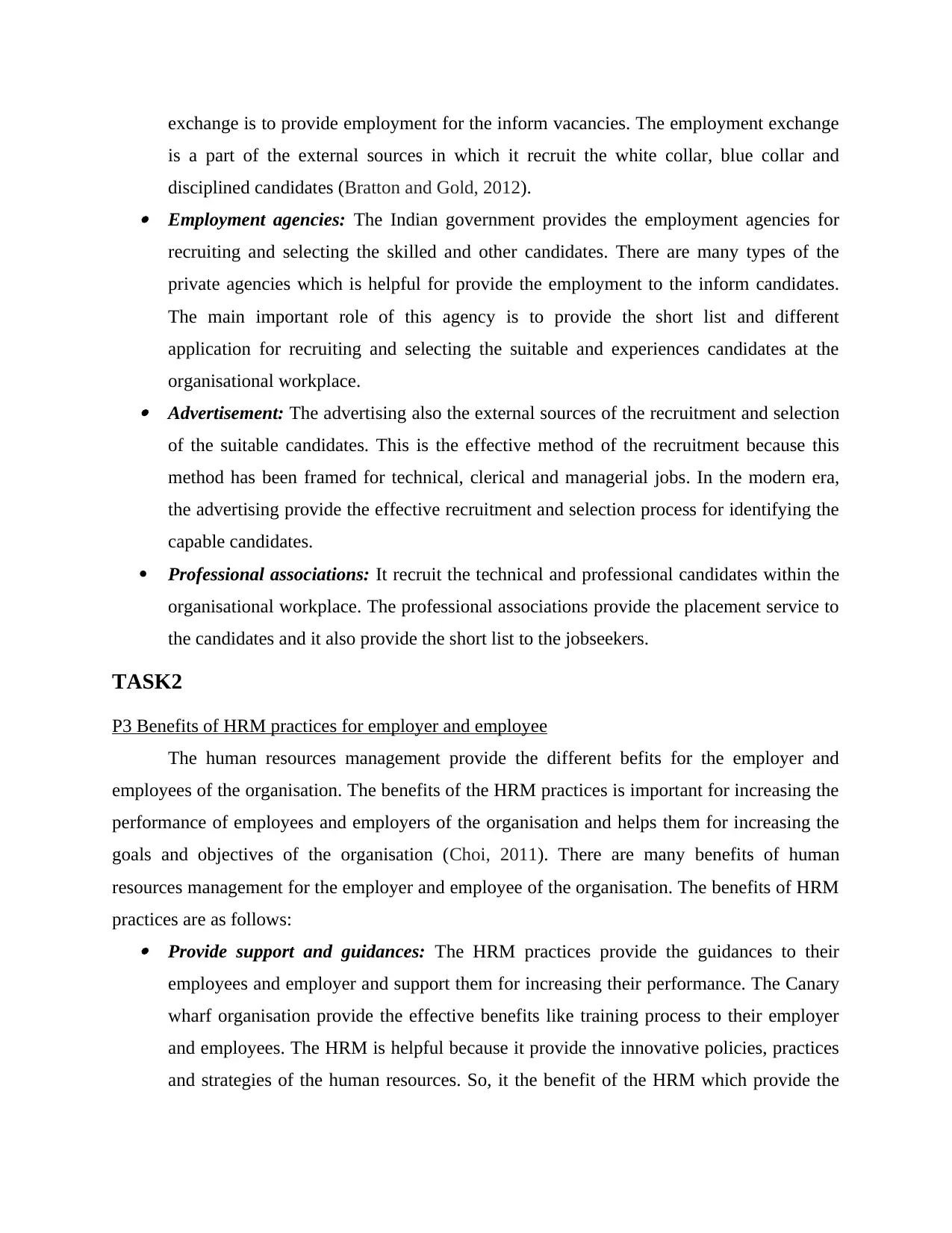
exchange is to provide employment for the inform vacancies. The employment exchange
is a part of the external sources in which it recruit the white collar, blue collar and
disciplined candidates (Bratton and Gold, 2012). Employment agencies: The Indian government provides the employment agencies for
recruiting and selecting the skilled and other candidates. There are many types of the
private agencies which is helpful for provide the employment to the inform candidates.
The main important role of this agency is to provide the short list and different
application for recruiting and selecting the suitable and experiences candidates at the
organisational workplace. Advertisement: The advertising also the external sources of the recruitment and selection
of the suitable candidates. This is the effective method of the recruitment because this
method has been framed for technical, clerical and managerial jobs. In the modern era,
the advertising provide the effective recruitment and selection process for identifying the
capable candidates.
Professional associations: It recruit the technical and professional candidates within the
organisational workplace. The professional associations provide the placement service to
the candidates and it also provide the short list to the jobseekers.
TASK2
P3 Benefits of HRM practices for employer and employee
The human resources management provide the different befits for the employer and
employees of the organisation. The benefits of the HRM practices is important for increasing the
performance of employees and employers of the organisation and helps them for increasing the
goals and objectives of the organisation (Choi, 2011). There are many benefits of human
resources management for the employer and employee of the organisation. The benefits of HRM
practices are as follows: Provide support and guidances: The HRM practices provide the guidances to their
employees and employer and support them for increasing their performance. The Canary
wharf organisation provide the effective benefits like training process to their employer
and employees. The HRM is helpful because it provide the innovative policies, practices
and strategies of the human resources. So, it the benefit of the HRM which provide the
is a part of the external sources in which it recruit the white collar, blue collar and
disciplined candidates (Bratton and Gold, 2012). Employment agencies: The Indian government provides the employment agencies for
recruiting and selecting the skilled and other candidates. There are many types of the
private agencies which is helpful for provide the employment to the inform candidates.
The main important role of this agency is to provide the short list and different
application for recruiting and selecting the suitable and experiences candidates at the
organisational workplace. Advertisement: The advertising also the external sources of the recruitment and selection
of the suitable candidates. This is the effective method of the recruitment because this
method has been framed for technical, clerical and managerial jobs. In the modern era,
the advertising provide the effective recruitment and selection process for identifying the
capable candidates.
Professional associations: It recruit the technical and professional candidates within the
organisational workplace. The professional associations provide the placement service to
the candidates and it also provide the short list to the jobseekers.
TASK2
P3 Benefits of HRM practices for employer and employee
The human resources management provide the different befits for the employer and
employees of the organisation. The benefits of the HRM practices is important for increasing the
performance of employees and employers of the organisation and helps them for increasing the
goals and objectives of the organisation (Choi, 2011). There are many benefits of human
resources management for the employer and employee of the organisation. The benefits of HRM
practices are as follows: Provide support and guidances: The HRM practices provide the guidances to their
employees and employer and support them for increasing their performance. The Canary
wharf organisation provide the effective benefits like training process to their employer
and employees. The HRM is helpful because it provide the innovative policies, practices
and strategies of the human resources. So, it the benefit of the HRM which provide the
⊘ This is a preview!⊘
Do you want full access?
Subscribe today to unlock all pages.

Trusted by 1+ million students worldwide
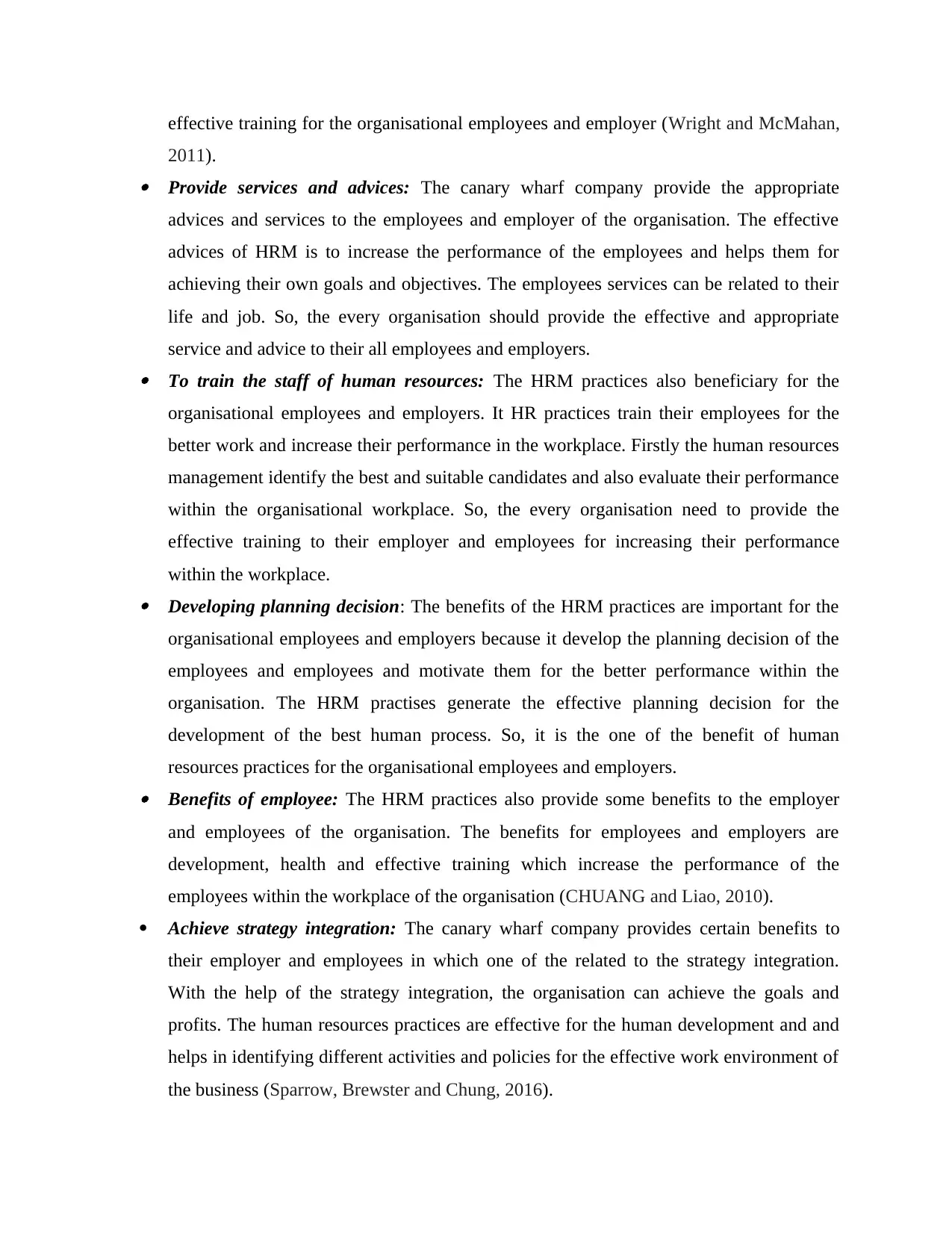
effective training for the organisational employees and employer (Wright and McMahan,
2011). Provide services and advices: The canary wharf company provide the appropriate
advices and services to the employees and employer of the organisation. The effective
advices of HRM is to increase the performance of the employees and helps them for
achieving their own goals and objectives. The employees services can be related to their
life and job. So, the every organisation should provide the effective and appropriate
service and advice to their all employees and employers. To train the staff of human resources: The HRM practices also beneficiary for the
organisational employees and employers. It HR practices train their employees for the
better work and increase their performance in the workplace. Firstly the human resources
management identify the best and suitable candidates and also evaluate their performance
within the organisational workplace. So, the every organisation need to provide the
effective training to their employer and employees for increasing their performance
within the workplace. Developing planning decision: The benefits of the HRM practices are important for the
organisational employees and employers because it develop the planning decision of the
employees and employees and motivate them for the better performance within the
organisation. The HRM practises generate the effective planning decision for the
development of the best human process. So, it is the one of the benefit of human
resources practices for the organisational employees and employers. Benefits of employee: The HRM practices also provide some benefits to the employer
and employees of the organisation. The benefits for employees and employers are
development, health and effective training which increase the performance of the
employees within the workplace of the organisation (CHUANG and Liao, 2010).
Achieve strategy integration: The canary wharf company provides certain benefits to
their employer and employees in which one of the related to the strategy integration.
With the help of the strategy integration, the organisation can achieve the goals and
profits. The human resources practices are effective for the human development and and
helps in identifying different activities and policies for the effective work environment of
the business (Sparrow, Brewster and Chung, 2016).
2011). Provide services and advices: The canary wharf company provide the appropriate
advices and services to the employees and employer of the organisation. The effective
advices of HRM is to increase the performance of the employees and helps them for
achieving their own goals and objectives. The employees services can be related to their
life and job. So, the every organisation should provide the effective and appropriate
service and advice to their all employees and employers. To train the staff of human resources: The HRM practices also beneficiary for the
organisational employees and employers. It HR practices train their employees for the
better work and increase their performance in the workplace. Firstly the human resources
management identify the best and suitable candidates and also evaluate their performance
within the organisational workplace. So, the every organisation need to provide the
effective training to their employer and employees for increasing their performance
within the workplace. Developing planning decision: The benefits of the HRM practices are important for the
organisational employees and employers because it develop the planning decision of the
employees and employees and motivate them for the better performance within the
organisation. The HRM practises generate the effective planning decision for the
development of the best human process. So, it is the one of the benefit of human
resources practices for the organisational employees and employers. Benefits of employee: The HRM practices also provide some benefits to the employer
and employees of the organisation. The benefits for employees and employers are
development, health and effective training which increase the performance of the
employees within the workplace of the organisation (CHUANG and Liao, 2010).
Achieve strategy integration: The canary wharf company provides certain benefits to
their employer and employees in which one of the related to the strategy integration.
With the help of the strategy integration, the organisation can achieve the goals and
profits. The human resources practices are effective for the human development and and
helps in identifying different activities and policies for the effective work environment of
the business (Sparrow, Brewster and Chung, 2016).
Paraphrase This Document
Need a fresh take? Get an instant paraphrase of this document with our AI Paraphraser
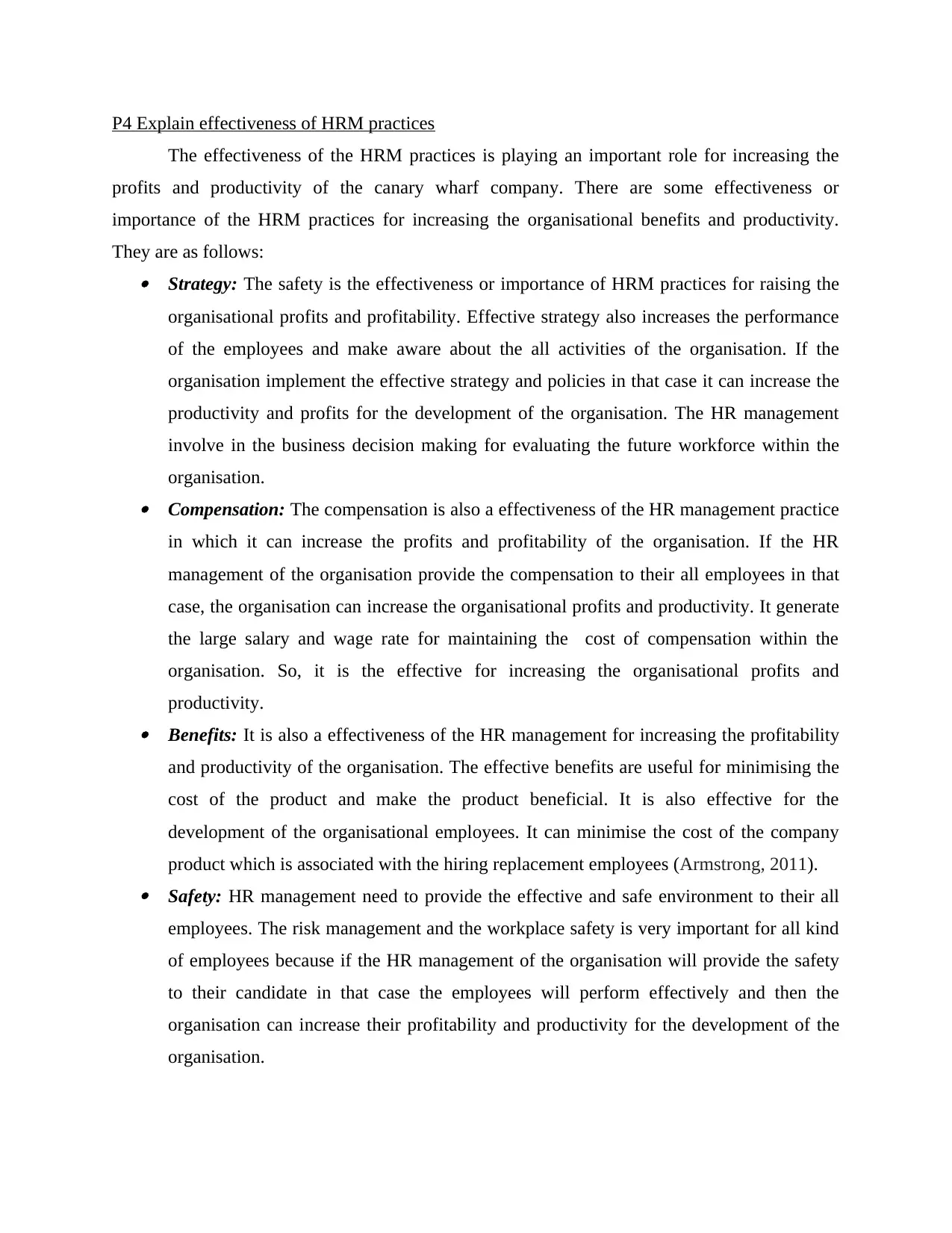
P4 Explain effectiveness of HRM practices
The effectiveness of the HRM practices is playing an important role for increasing the
profits and productivity of the canary wharf company. There are some effectiveness or
importance of the HRM practices for increasing the organisational benefits and productivity.
They are as follows: Strategy: The safety is the effectiveness or importance of HRM practices for raising the
organisational profits and profitability. Effective strategy also increases the performance
of the employees and make aware about the all activities of the organisation. If the
organisation implement the effective strategy and policies in that case it can increase the
productivity and profits for the development of the organisation. The HR management
involve in the business decision making for evaluating the future workforce within the
organisation. Compensation: The compensation is also a effectiveness of the HR management practice
in which it can increase the profits and profitability of the organisation. If the HR
management of the organisation provide the compensation to their all employees in that
case, the organisation can increase the organisational profits and productivity. It generate
the large salary and wage rate for maintaining the cost of compensation within the
organisation. So, it is the effective for increasing the organisational profits and
productivity. Benefits: It is also a effectiveness of the HR management for increasing the profitability
and productivity of the organisation. The effective benefits are useful for minimising the
cost of the product and make the product beneficial. It is also effective for the
development of the organisational employees. It can minimise the cost of the company
product which is associated with the hiring replacement employees (Armstrong, 2011). Safety: HR management need to provide the effective and safe environment to their all
employees. The risk management and the workplace safety is very important for all kind
of employees because if the HR management of the organisation will provide the safety
to their candidate in that case the employees will perform effectively and then the
organisation can increase their profitability and productivity for the development of the
organisation.
The effectiveness of the HRM practices is playing an important role for increasing the
profits and productivity of the canary wharf company. There are some effectiveness or
importance of the HRM practices for increasing the organisational benefits and productivity.
They are as follows: Strategy: The safety is the effectiveness or importance of HRM practices for raising the
organisational profits and profitability. Effective strategy also increases the performance
of the employees and make aware about the all activities of the organisation. If the
organisation implement the effective strategy and policies in that case it can increase the
productivity and profits for the development of the organisation. The HR management
involve in the business decision making for evaluating the future workforce within the
organisation. Compensation: The compensation is also a effectiveness of the HR management practice
in which it can increase the profits and profitability of the organisation. If the HR
management of the organisation provide the compensation to their all employees in that
case, the organisation can increase the organisational profits and productivity. It generate
the large salary and wage rate for maintaining the cost of compensation within the
organisation. So, it is the effective for increasing the organisational profits and
productivity. Benefits: It is also a effectiveness of the HR management for increasing the profitability
and productivity of the organisation. The effective benefits are useful for minimising the
cost of the product and make the product beneficial. It is also effective for the
development of the organisational employees. It can minimise the cost of the company
product which is associated with the hiring replacement employees (Armstrong, 2011). Safety: HR management need to provide the effective and safe environment to their all
employees. The risk management and the workplace safety is very important for all kind
of employees because if the HR management of the organisation will provide the safety
to their candidate in that case the employees will perform effectively and then the
organisation can increase their profitability and productivity for the development of the
organisation.
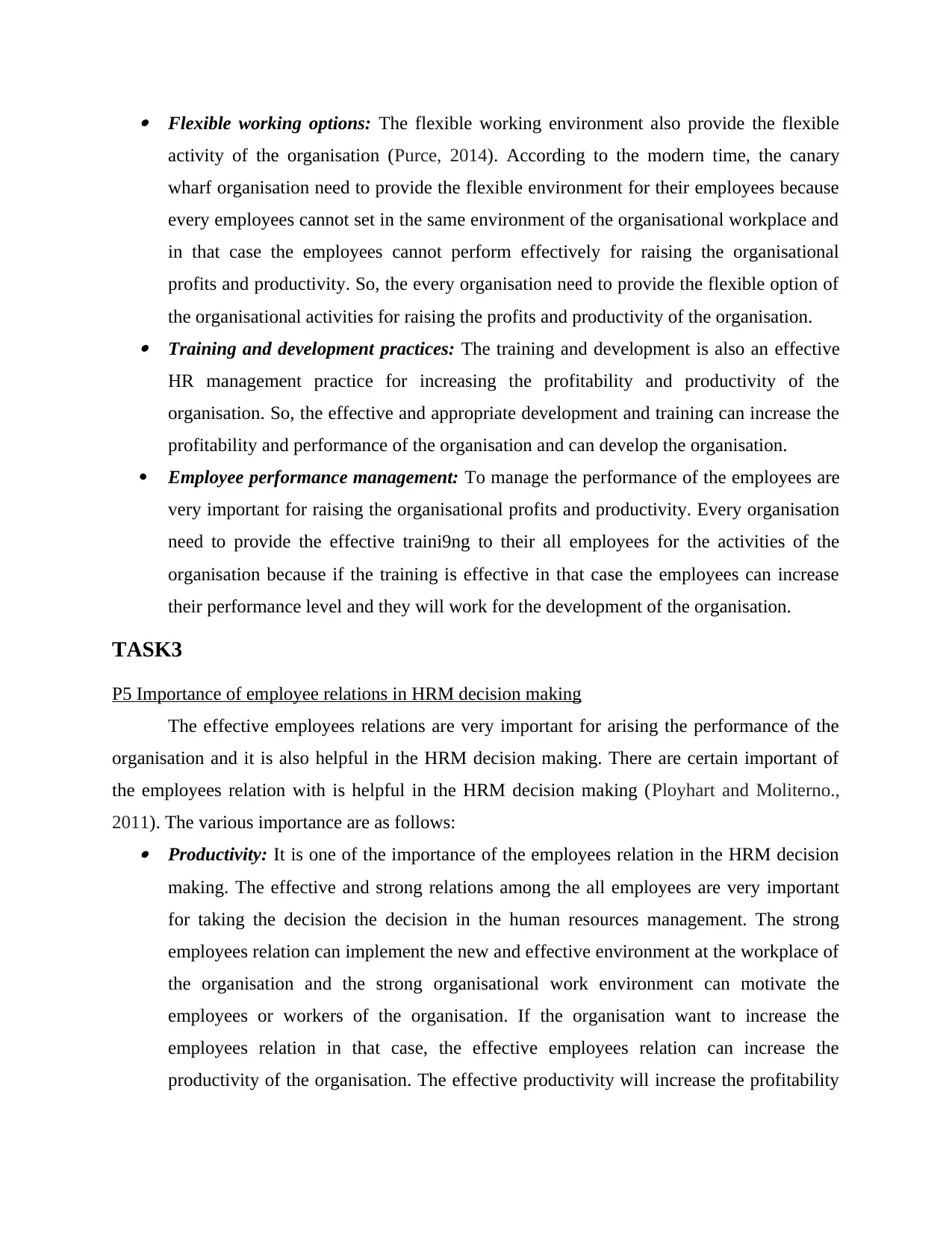
Flexible working options: The flexible working environment also provide the flexible
activity of the organisation (Purce, 2014). According to the modern time, the canary
wharf organisation need to provide the flexible environment for their employees because
every employees cannot set in the same environment of the organisational workplace and
in that case the employees cannot perform effectively for raising the organisational
profits and productivity. So, the every organisation need to provide the flexible option of
the organisational activities for raising the profits and productivity of the organisation. Training and development practices: The training and development is also an effective
HR management practice for increasing the profitability and productivity of the
organisation. So, the effective and appropriate development and training can increase the
profitability and performance of the organisation and can develop the organisation.
Employee performance management: To manage the performance of the employees are
very important for raising the organisational profits and productivity. Every organisation
need to provide the effective traini9ng to their all employees for the activities of the
organisation because if the training is effective in that case the employees can increase
their performance level and they will work for the development of the organisation.
TASK3
P5 Importance of employee relations in HRM decision making
The effective employees relations are very important for arising the performance of the
organisation and it is also helpful in the HRM decision making. There are certain important of
the employees relation with is helpful in the HRM decision making (Ployhart and Moliterno.,
2011). The various importance are as follows: Productivity: It is one of the importance of the employees relation in the HRM decision
making. The effective and strong relations among the all employees are very important
for taking the decision the decision in the human resources management. The strong
employees relation can implement the new and effective environment at the workplace of
the organisation and the strong organisational work environment can motivate the
employees or workers of the organisation. If the organisation want to increase the
employees relation in that case, the effective employees relation can increase the
productivity of the organisation. The effective productivity will increase the profitability
activity of the organisation (Purce, 2014). According to the modern time, the canary
wharf organisation need to provide the flexible environment for their employees because
every employees cannot set in the same environment of the organisational workplace and
in that case the employees cannot perform effectively for raising the organisational
profits and productivity. So, the every organisation need to provide the flexible option of
the organisational activities for raising the profits and productivity of the organisation. Training and development practices: The training and development is also an effective
HR management practice for increasing the profitability and productivity of the
organisation. So, the effective and appropriate development and training can increase the
profitability and performance of the organisation and can develop the organisation.
Employee performance management: To manage the performance of the employees are
very important for raising the organisational profits and productivity. Every organisation
need to provide the effective traini9ng to their all employees for the activities of the
organisation because if the training is effective in that case the employees can increase
their performance level and they will work for the development of the organisation.
TASK3
P5 Importance of employee relations in HRM decision making
The effective employees relations are very important for arising the performance of the
organisation and it is also helpful in the HRM decision making. There are certain important of
the employees relation with is helpful in the HRM decision making (Ployhart and Moliterno.,
2011). The various importance are as follows: Productivity: It is one of the importance of the employees relation in the HRM decision
making. The effective and strong relations among the all employees are very important
for taking the decision the decision in the human resources management. The strong
employees relation can implement the new and effective environment at the workplace of
the organisation and the strong organisational work environment can motivate the
employees or workers of the organisation. If the organisation want to increase the
employees relation in that case, the effective employees relation can increase the
productivity of the organisation. The effective productivity will increase the profitability
⊘ This is a preview!⊘
Do you want full access?
Subscribe today to unlock all pages.

Trusted by 1+ million students worldwide
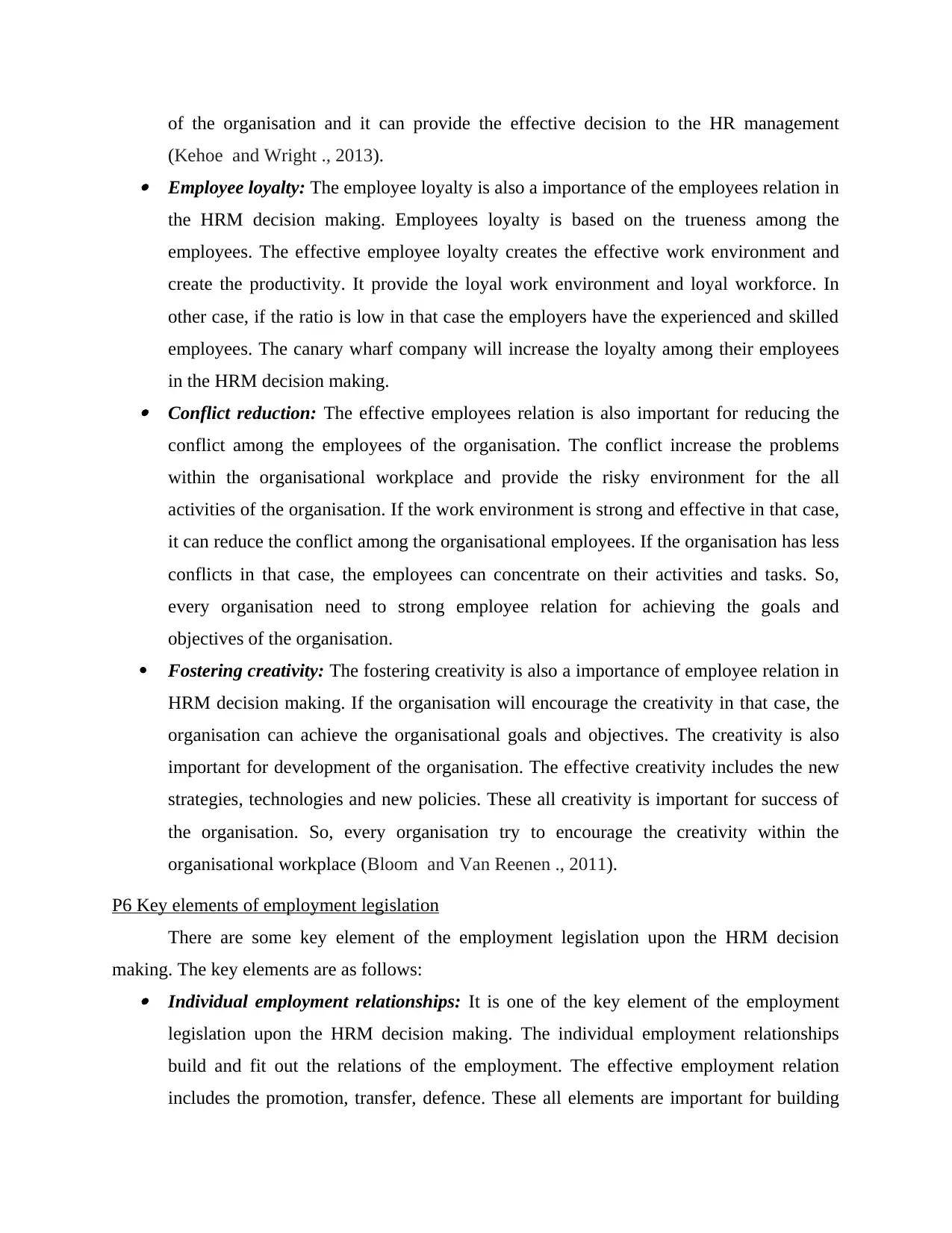
of the organisation and it can provide the effective decision to the HR management
(Kehoe and Wright ., 2013). Employee loyalty: The employee loyalty is also a importance of the employees relation in
the HRM decision making. Employees loyalty is based on the trueness among the
employees. The effective employee loyalty creates the effective work environment and
create the productivity. It provide the loyal work environment and loyal workforce. In
other case, if the ratio is low in that case the employers have the experienced and skilled
employees. The canary wharf company will increase the loyalty among their employees
in the HRM decision making. Conflict reduction: The effective employees relation is also important for reducing the
conflict among the employees of the organisation. The conflict increase the problems
within the organisational workplace and provide the risky environment for the all
activities of the organisation. If the work environment is strong and effective in that case,
it can reduce the conflict among the organisational employees. If the organisation has less
conflicts in that case, the employees can concentrate on their activities and tasks. So,
every organisation need to strong employee relation for achieving the goals and
objectives of the organisation.
Fostering creativity: The fostering creativity is also a importance of employee relation in
HRM decision making. If the organisation will encourage the creativity in that case, the
organisation can achieve the organisational goals and objectives. The creativity is also
important for development of the organisation. The effective creativity includes the new
strategies, technologies and new policies. These all creativity is important for success of
the organisation. So, every organisation try to encourage the creativity within the
organisational workplace (Bloom and Van Reenen ., 2011).
P6 Key elements of employment legislation
There are some key element of the employment legislation upon the HRM decision
making. The key elements are as follows: Individual employment relationships: It is one of the key element of the employment
legislation upon the HRM decision making. The individual employment relationships
build and fit out the relations of the employment. The effective employment relation
includes the promotion, transfer, defence. These all elements are important for building
(Kehoe and Wright ., 2013). Employee loyalty: The employee loyalty is also a importance of the employees relation in
the HRM decision making. Employees loyalty is based on the trueness among the
employees. The effective employee loyalty creates the effective work environment and
create the productivity. It provide the loyal work environment and loyal workforce. In
other case, if the ratio is low in that case the employers have the experienced and skilled
employees. The canary wharf company will increase the loyalty among their employees
in the HRM decision making. Conflict reduction: The effective employees relation is also important for reducing the
conflict among the employees of the organisation. The conflict increase the problems
within the organisational workplace and provide the risky environment for the all
activities of the organisation. If the work environment is strong and effective in that case,
it can reduce the conflict among the organisational employees. If the organisation has less
conflicts in that case, the employees can concentrate on their activities and tasks. So,
every organisation need to strong employee relation for achieving the goals and
objectives of the organisation.
Fostering creativity: The fostering creativity is also a importance of employee relation in
HRM decision making. If the organisation will encourage the creativity in that case, the
organisation can achieve the organisational goals and objectives. The creativity is also
important for development of the organisation. The effective creativity includes the new
strategies, technologies and new policies. These all creativity is important for success of
the organisation. So, every organisation try to encourage the creativity within the
organisational workplace (Bloom and Van Reenen ., 2011).
P6 Key elements of employment legislation
There are some key element of the employment legislation upon the HRM decision
making. The key elements are as follows: Individual employment relationships: It is one of the key element of the employment
legislation upon the HRM decision making. The individual employment relationships
build and fit out the relations of the employment. The effective employment relation
includes the promotion, transfer, defence. These all elements are important for building
Paraphrase This Document
Need a fresh take? Get an instant paraphrase of this document with our AI Paraphraser
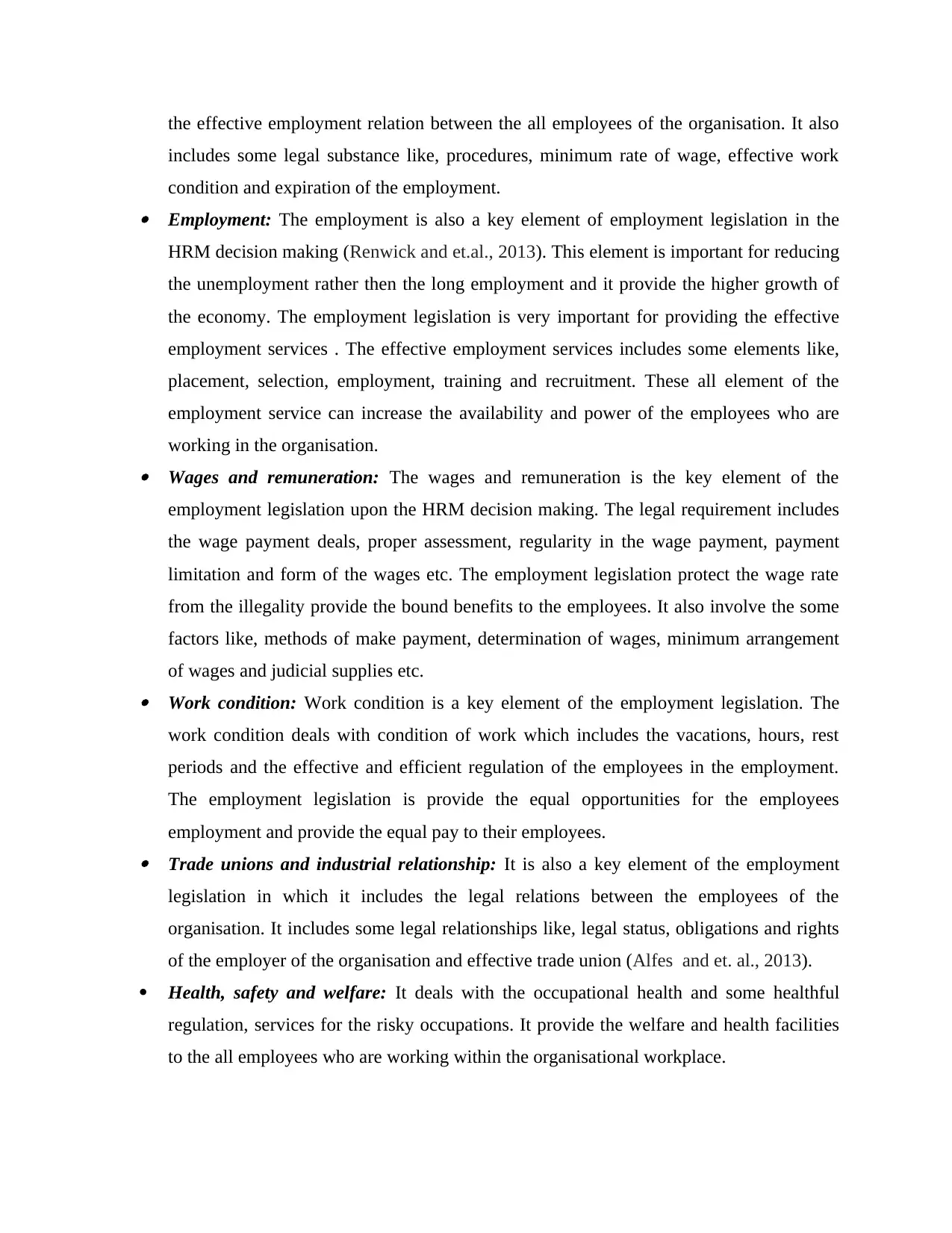
the effective employment relation between the all employees of the organisation. It also
includes some legal substance like, procedures, minimum rate of wage, effective work
condition and expiration of the employment. Employment: The employment is also a key element of employment legislation in the
HRM decision making (Renwick and et.al., 2013). This element is important for reducing
the unemployment rather then the long employment and it provide the higher growth of
the economy. The employment legislation is very important for providing the effective
employment services . The effective employment services includes some elements like,
placement, selection, employment, training and recruitment. These all element of the
employment service can increase the availability and power of the employees who are
working in the organisation. Wages and remuneration: The wages and remuneration is the key element of the
employment legislation upon the HRM decision making. The legal requirement includes
the wage payment deals, proper assessment, regularity in the wage payment, payment
limitation and form of the wages etc. The employment legislation protect the wage rate
from the illegality provide the bound benefits to the employees. It also involve the some
factors like, methods of make payment, determination of wages, minimum arrangement
of wages and judicial supplies etc. Work condition: Work condition is a key element of the employment legislation. The
work condition deals with condition of work which includes the vacations, hours, rest
periods and the effective and efficient regulation of the employees in the employment.
The employment legislation is provide the equal opportunities for the employees
employment and provide the equal pay to their employees. Trade unions and industrial relationship: It is also a key element of the employment
legislation in which it includes the legal relations between the employees of the
organisation. It includes some legal relationships like, legal status, obligations and rights
of the employer of the organisation and effective trade union (Alfes and et. al., 2013).
Health, safety and welfare: It deals with the occupational health and some healthful
regulation, services for the risky occupations. It provide the welfare and health facilities
to the all employees who are working within the organisational workplace.
includes some legal substance like, procedures, minimum rate of wage, effective work
condition and expiration of the employment. Employment: The employment is also a key element of employment legislation in the
HRM decision making (Renwick and et.al., 2013). This element is important for reducing
the unemployment rather then the long employment and it provide the higher growth of
the economy. The employment legislation is very important for providing the effective
employment services . The effective employment services includes some elements like,
placement, selection, employment, training and recruitment. These all element of the
employment service can increase the availability and power of the employees who are
working in the organisation. Wages and remuneration: The wages and remuneration is the key element of the
employment legislation upon the HRM decision making. The legal requirement includes
the wage payment deals, proper assessment, regularity in the wage payment, payment
limitation and form of the wages etc. The employment legislation protect the wage rate
from the illegality provide the bound benefits to the employees. It also involve the some
factors like, methods of make payment, determination of wages, minimum arrangement
of wages and judicial supplies etc. Work condition: Work condition is a key element of the employment legislation. The
work condition deals with condition of work which includes the vacations, hours, rest
periods and the effective and efficient regulation of the employees in the employment.
The employment legislation is provide the equal opportunities for the employees
employment and provide the equal pay to their employees. Trade unions and industrial relationship: It is also a key element of the employment
legislation in which it includes the legal relations between the employees of the
organisation. It includes some legal relationships like, legal status, obligations and rights
of the employer of the organisation and effective trade union (Alfes and et. al., 2013).
Health, safety and welfare: It deals with the occupational health and some healthful
regulation, services for the risky occupations. It provide the welfare and health facilities
to the all employees who are working within the organisational workplace.
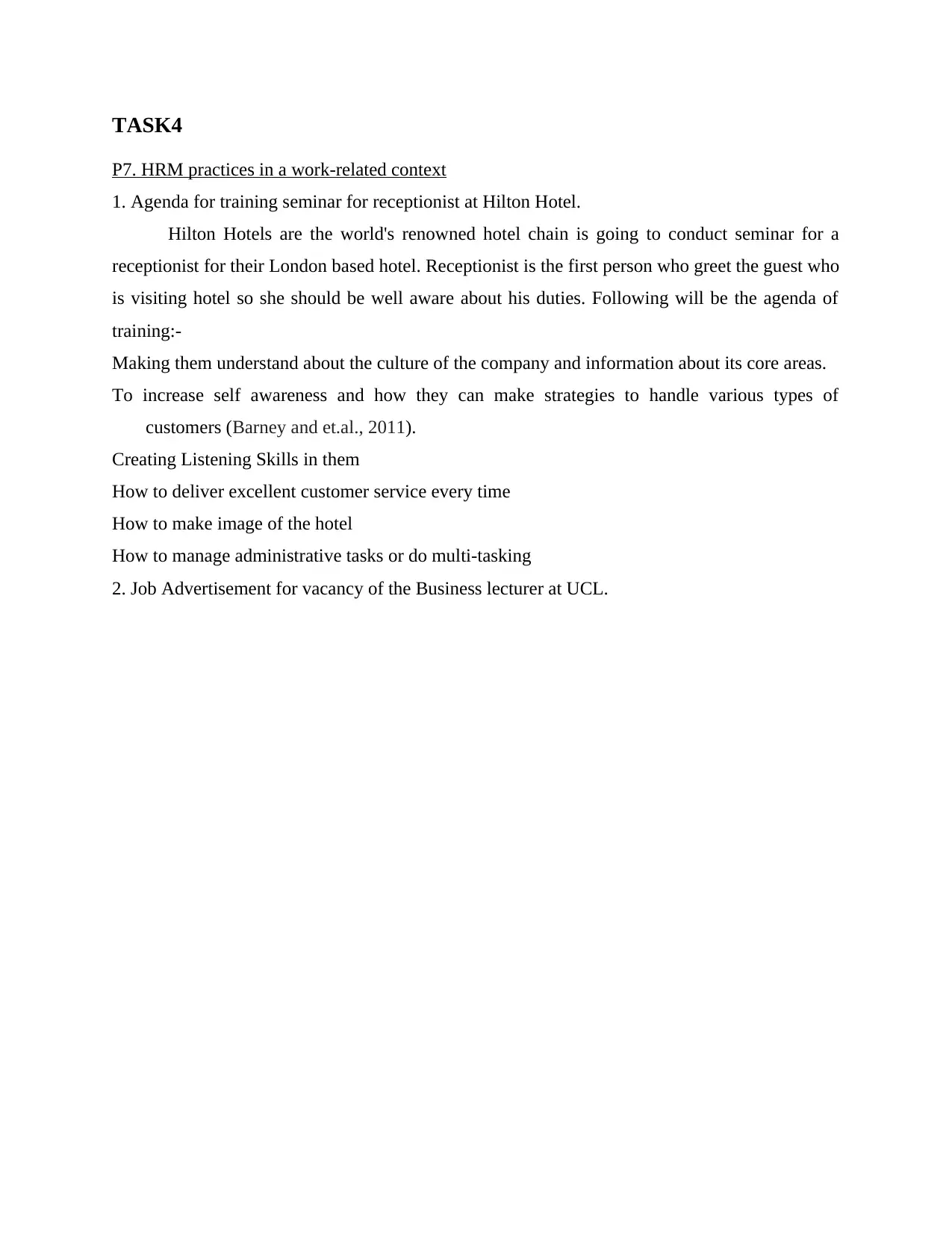
TASK4
P7. HRM practices in a work-related context
1. Agenda for training seminar for receptionist at Hilton Hotel.
Hilton Hotels are the world's renowned hotel chain is going to conduct seminar for a
receptionist for their London based hotel. Receptionist is the first person who greet the guest who
is visiting hotel so she should be well aware about his duties. Following will be the agenda of
training:-
Making them understand about the culture of the company and information about its core areas.
To increase self awareness and how they can make strategies to handle various types of
customers (Barney and et.al., 2011).
Creating Listening Skills in them
How to deliver excellent customer service every time
How to make image of the hotel
How to manage administrative tasks or do multi-tasking
2. Job Advertisement for vacancy of the Business lecturer at UCL.
P7. HRM practices in a work-related context
1. Agenda for training seminar for receptionist at Hilton Hotel.
Hilton Hotels are the world's renowned hotel chain is going to conduct seminar for a
receptionist for their London based hotel. Receptionist is the first person who greet the guest who
is visiting hotel so she should be well aware about his duties. Following will be the agenda of
training:-
Making them understand about the culture of the company and information about its core areas.
To increase self awareness and how they can make strategies to handle various types of
customers (Barney and et.al., 2011).
Creating Listening Skills in them
How to deliver excellent customer service every time
How to make image of the hotel
How to manage administrative tasks or do multi-tasking
2. Job Advertisement for vacancy of the Business lecturer at UCL.
⊘ This is a preview!⊘
Do you want full access?
Subscribe today to unlock all pages.

Trusted by 1+ million students worldwide
1 out of 17
Related Documents
Your All-in-One AI-Powered Toolkit for Academic Success.
+13062052269
info@desklib.com
Available 24*7 on WhatsApp / Email
![[object Object]](/_next/static/media/star-bottom.7253800d.svg)
Unlock your academic potential
Copyright © 2020–2025 A2Z Services. All Rights Reserved. Developed and managed by ZUCOL.





